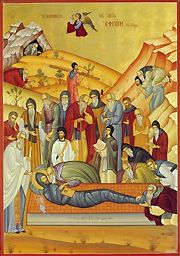|
|
by George Aramath
Page 1 | Page 2 | Page 3 | Page 4 | Page 5 | Page 6 | References
The circumstances around his death only reconfirm
his legacy. It is believed that a great famine struck Edessa, leaving many poor
and hungry. St. Ephrem discovers that some were hoarding food all to themselves.
When St. Ephrem questions them, they reply that they cannot trust anyone to
distribute the food fairly. So St. Ephrem himself volunteers to do it. By not
rejecting this offer, it also shows the amount of respect and credibility held
by others for St. Ephrem. It is said that his death followed shortly thereafter
in 373 A.D.
In looking at the vita of St. Ephrem, one sees a difference in how the Eastern
and Oriental Orthodox first perceived of this saint. This difference can best be
explained by examining his icons. In the Byzantine tradition, St. Ephrem was
generally seen as a hermit. They viewed him living inside a cave, producing his
many works in pray and solitude.
This icon is known as "The Repose of St. Ephrem". It strikingly shows the last
scene of the saint's burial. One sees caves in the background, an allusion to
the saint's secluded way of life. In addition, Byzantine tradition includes
writings of legendary journeys of St. Ephrem that reinforces this viewpoint. One
of these visits included a trip to see St. Basil, whom he shared many common
beliefs. Another visit involved Abba Bishoi (Pisoes) in the monasteries of the
Wadi Natun, Egypt. (5) These legends strengthen the idea that St. Ephrem lived the
monastic life and came in contact with those who also practiced it.
On the other hand, the Syrian tradition looks at St. Ephrem from a different
perspective. He does, as held by the Eastern tradition, lead a life set apart
for God that includes among many other things, a consecrated life of virginity
and celibacy. As mentioned earlier, he was assigned to be a teacher by Mor Yacob
and is also seen as a caretaker and advisor to the bishops he served. In fact,
he would be in the company of the bishops for over seventy years of his life.
From this, one can classify St. Ephrem to be a "public monk", meaning that he
lived the life of a monk within the social settings of the day.
Page 1 | Page 2 | Page 3 | Page 4 | Page 5 | Page 6 | References
Church Fathers | Faith | History | Inspirational Articles | Essays | Sermons | Library - Home | Baselios Church Home
-------
Malankara World
A service of St. Basil's Syriac Orthodox
Church, Ohio
Copyright © 2009-2020 - ICBS Group. All Rights Reserved.
Disclaimer
Website designed, built, and hosted by
International Cyber Business Services, Inc., Hudson, Ohio